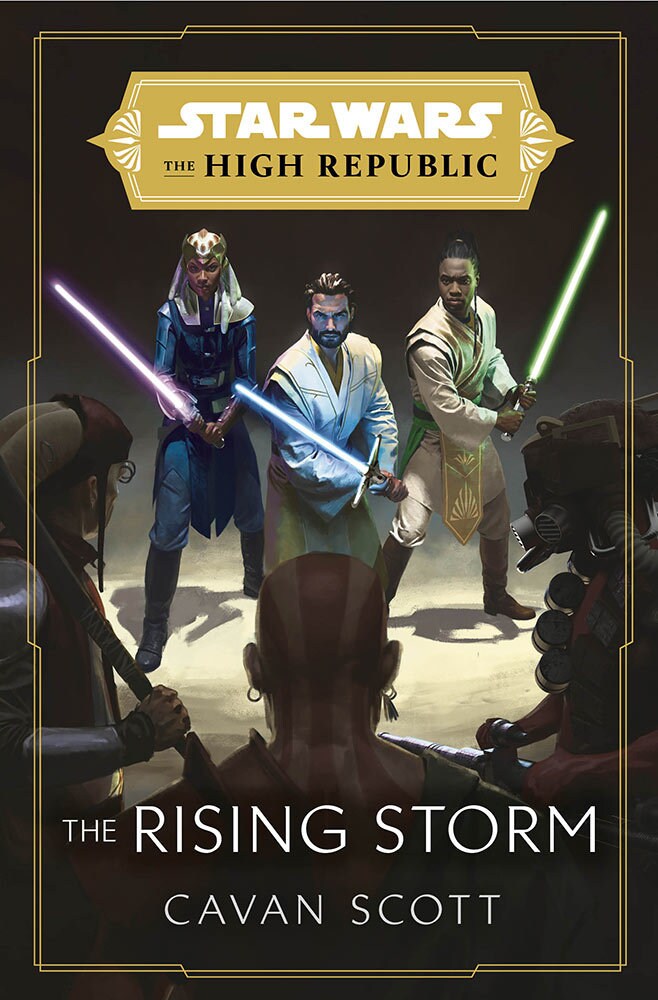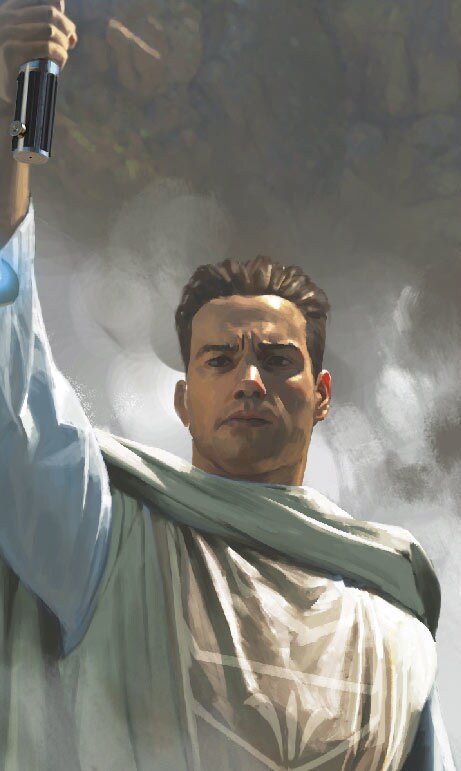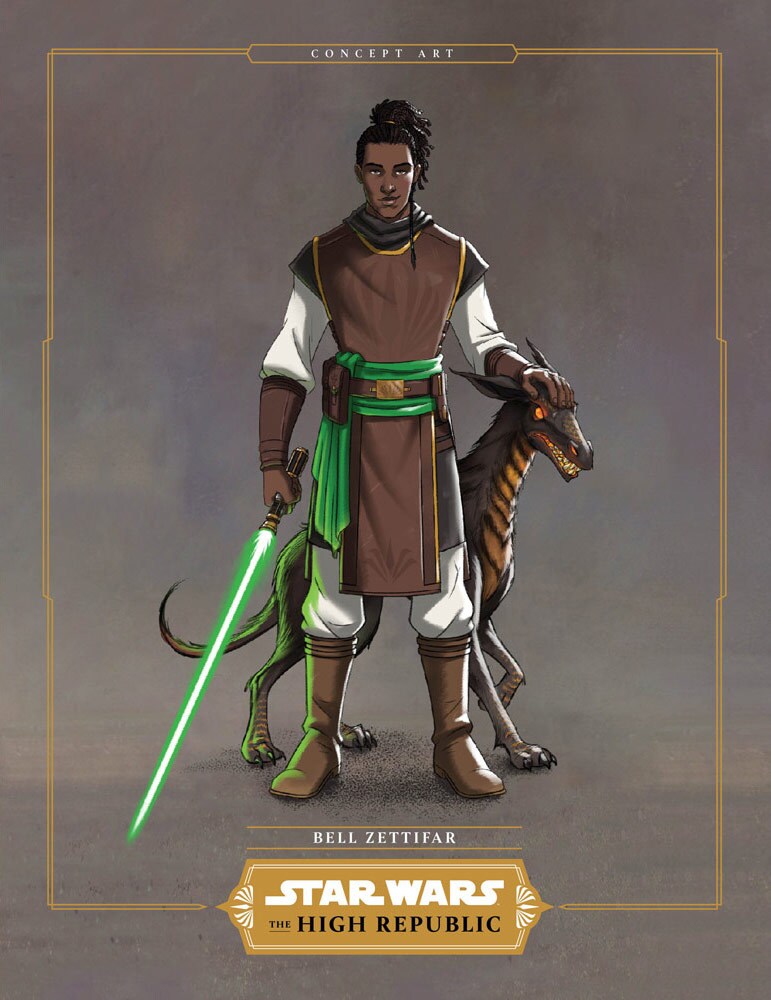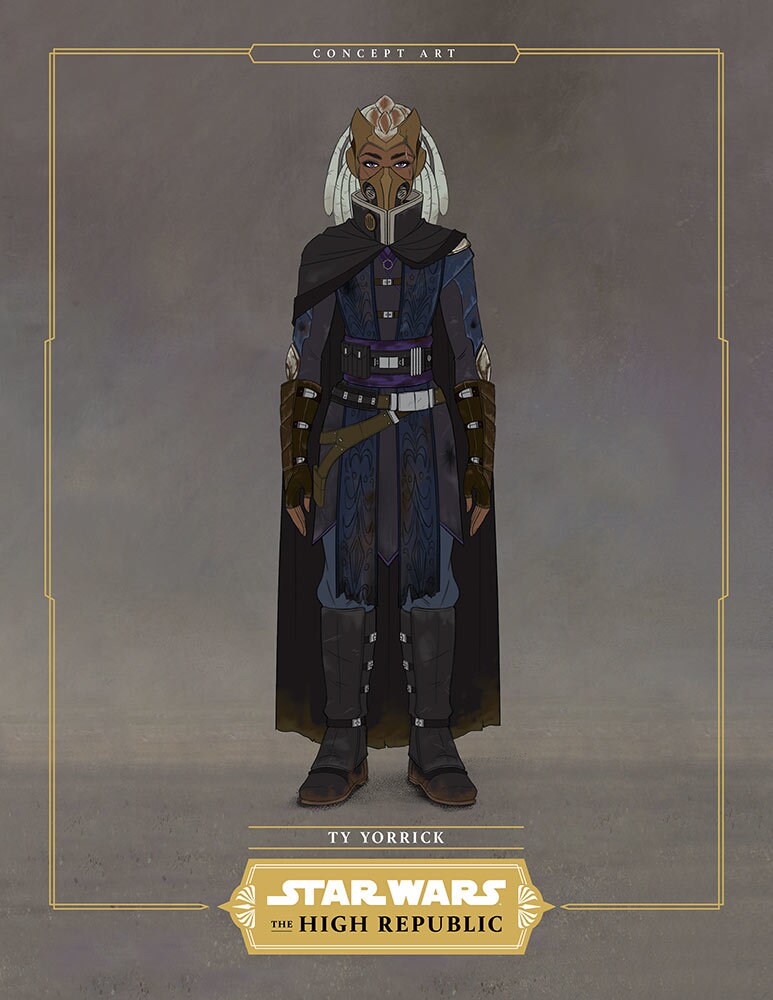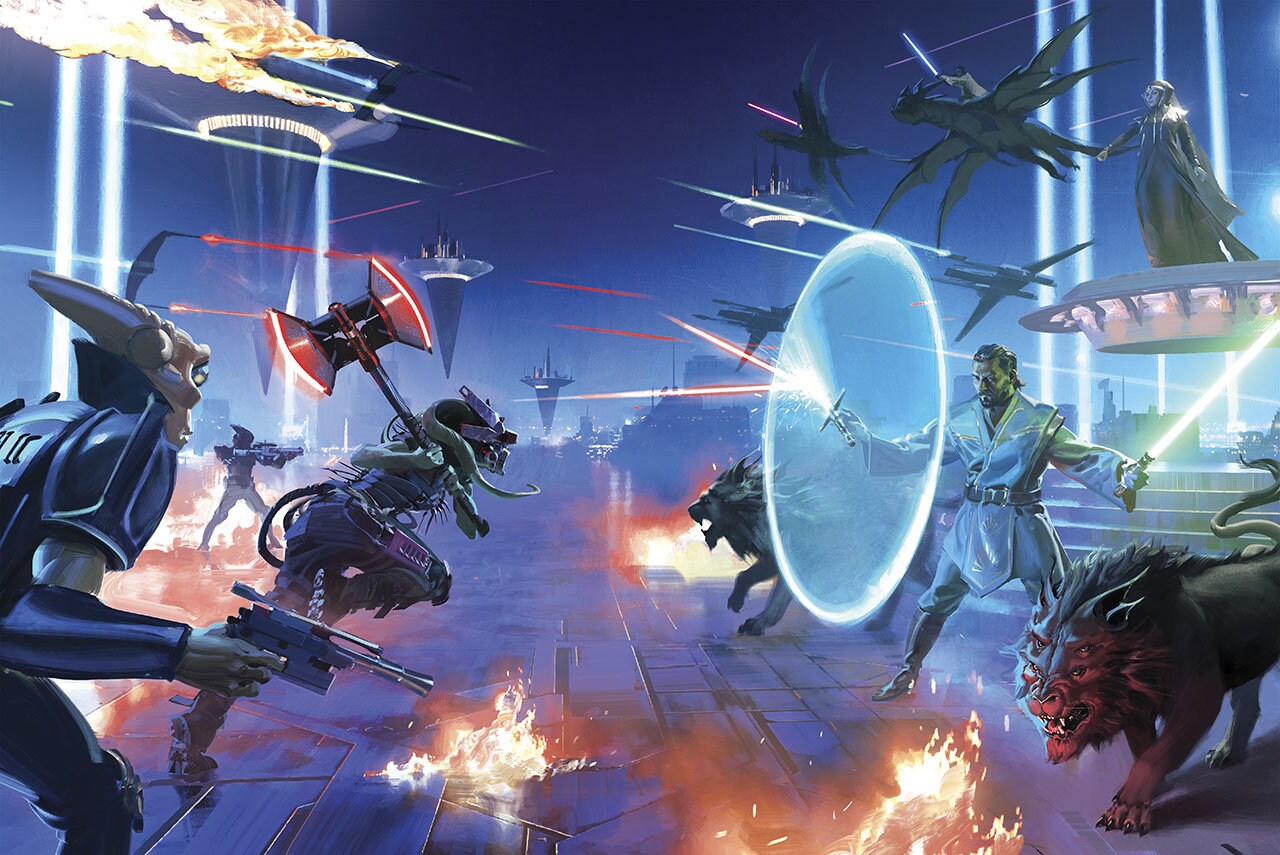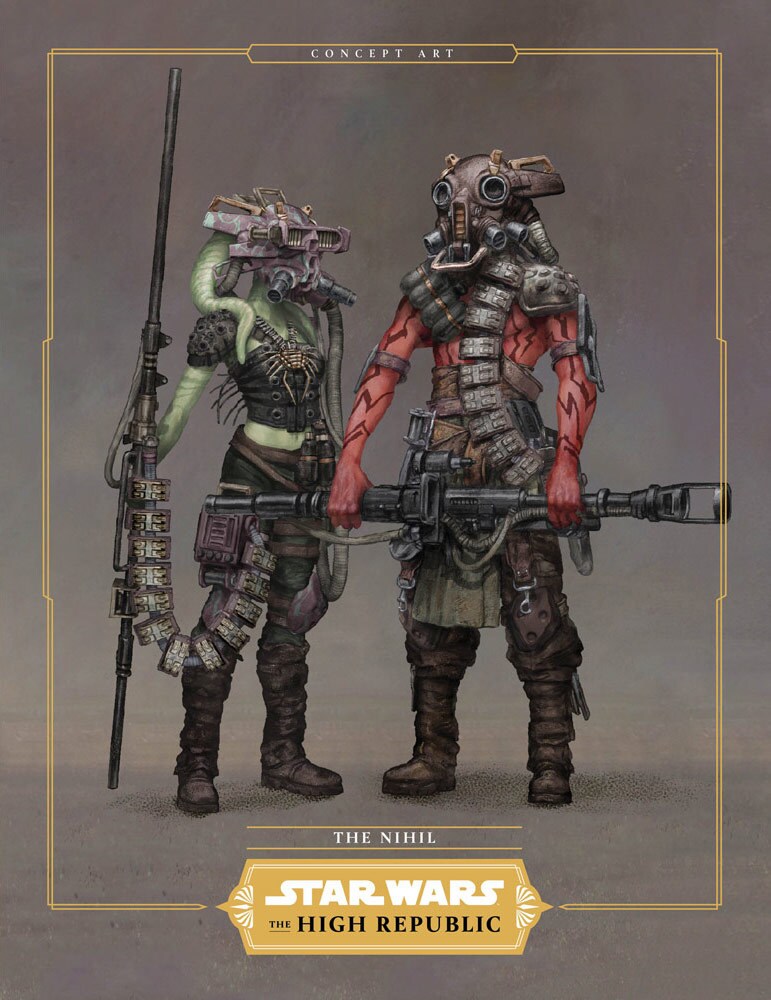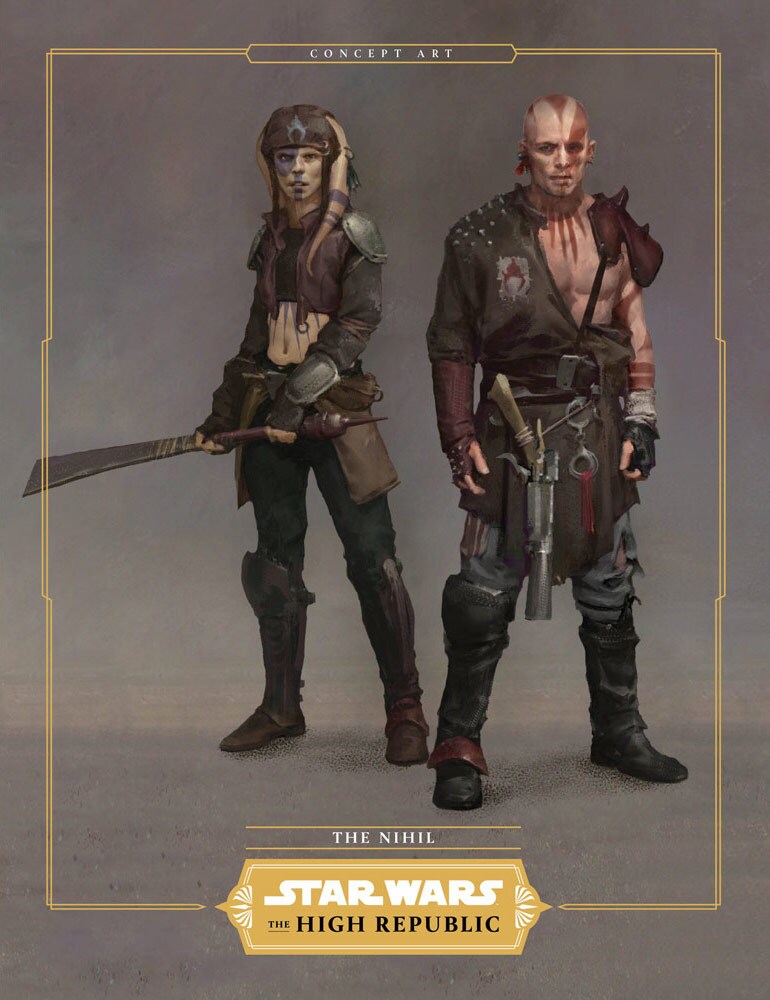Author Cavan Scott speaks to StarWars.com about telling a more grown-up story, mercenary Jedi, and the influences on his new novel.
Avar. Loden. Bell. Elzar. And we can’t forget Ember. Earlier this year, readers were introduced to a colorful cast of memorable characters in Star Wars: The High Republic: Light of the Jedi, the first novel to kick off Lucasfilm’s new storytelling initiative that took fans back to the prime of the Jedi Order. Now, the second adult novel in the series, Star Wars: The High Republic: The Rising Storm, is ready to propel fans deeper into this previously unexplored Star Wars era. Written by Cavan Scott, one of the architects of The High Republic initiative, The Rising Storm centers around The Republic Fair: a grand showcase of the possibilities and the peace of the expanding Republic, organized by the chancellor. But the Fair has also gained the attention of the villainous Nihil, whose thirst for chaos and destruction is yet to be quenched. To celebrate the novel’s release, StarWars.com talked with Scott, hoping he could shed some spoiler-free light on the tumultuous events to come.
StarWars.com: You’re well known for years of amazing storytelling in the Star Wars galaxy, particularly for young readers. And while you’ve had a hand in some memorable older audience work, like the From a Certain Point of View short stories and the Dooku: Jedi Lost audio drama, The Rising Storm is your first adult Star Wars novel. How is your approach to a project like this different from some of your previous work?
Cavan Scott: Well, it’s interesting because I do switch from younger reader to adult novels in other franchises and also my own work, as well. And so, I always approach the story the same way. A story is a story, no matter who you’re trying to tell it to. The difference is, obviously, the gaze it’s going through. So, when I was thinking about the story, when I was planning what would happen, how it would work, the actual storytelling mechanics were very similar to what I would do anyway. Obviously, you have a little bit more freedom when you’re writing for an adult audience and dealing with some of the more darker areas of the story. And in this story, there are quite a lot of dark areas. For people who only know me for my Star Wars work, it’s probably the darkest thing they'll have read of mine, which might be a shock. But yeah, obviously with a book for an adult audience, you can really tackle things that you wouldn’t, and you shouldn’t, tackle for a middle-grade audience, for example. And it gives you a chance to really delve into the consequences of the action that you see. Because a lot of the time in Star Wars, when you’re writing for younger readers, it’s excitement, it’s thrilling chases, it’s all the things we expect from Star Wars, but the pace just keeps going and going and going, and you don’t really -- actually you do deal with the consequences of it, but you obviously do it in a way that’s not going to traumatize any of your readers. I think it’s important with kids to show them there are consequences for actions, especially when you’re dealing with situations when there is violence and there is peril. But yeah, obviously you can get into those consequences in more detail with an adult novel.
StarWars.com: Not only are you writing for a different audience with The Rising Storm, you’re also writing in a different medium -- your work in The High Republic thus far has been heavily focused on the comic storylines. What are some of the pros and cons writing a major story installment in traditional prose, instead of a more visual medium?
Cavan Scott: It’s interesting, one of the biggest cons for me is that I love working in a team. So that’s why I love visual and audio and, more recently, TV work, because you’re one part of a bigger team telling the story, constructing the story. The good thing about this project is that team is built into it, because of the team of other writers I’ve been working with for the last couple of years putting it together. But yeah, it’s always daunting for me, whenever I return to prose, to realize that, you know, there’s not going to be a big conversation between me and an artist, or me and a director, or me and an actor. It’s me and the page for many, many months. So that’s always a bit daunting. So that’s the major con for me.
For the pros, it is, I suppose, the sense of scale. So, you know, in a comic, you’re dealing with 20 pages in a month, so it’s obviously over the space of a run, especially ongoing runs like The High Republic. That is a lot of storytelling, but obviously you are limited in page count. So with the novel, I’ve been able to get into things in far more depth, again, and just the sheer scale of the [Republic] Fair, which is needed for the Republic Fair. And it also meant I’ve been dealing with more POVs, point of views, than I think I’ve ever dealt with in a novel. Which was, again, a daunting aspect of this one.
When I start a novel, I like to plan out, on a big board, all the characters, especially when you’re part of an ongoing story: where those characters are, when we’ve last seen them. So a lot of the characters from Light of the Jedi, where were they? Elzar Mann is a good example: where was he in those final moments? And then, also, some of the other characters we pick up from the comics and other books. And then I plan where they’re going to be at the end, and then fill in the middle, and work out the most interesting way for them to get through.
When I realized how many characters are in this book, yeah, that was a moment you have to sit back and go, right, I’m going to need to plan every moment of this, while still giving myself the chance to be surprised by some of the characters as well, because there are a lot of moving parts. And the only additional thing for this one is that I drew a map of the Fair as well, because I needed to know where everything was, including stuff that never made it into the novel. So, yeah, those were the first things I did.
StarWars.com: When talking about all these characters and mapping out their journeys, many of these characters have been introduced before, specifically in Charles Soule’s Light of the Jedi. What characters, introduced in the first book, were you most excited to pick up in The Rising Storm?
Cavan Scott: Elzar [Mann]. Absolutely Elzar. Because I’ve been writing Avar Kriss in the comics. And the interesting thing about that is the character of Avar was actually two characters, originally. So I had a character who was the marshal of Starlight and Charles had a character -- and I can’t remember which one was called Avar now, it seems a long time ago -- but the characters were very similar and we decided to amalgamate them and make them the same person. And it really helped move that story through. So, writing Avar -- yeah, Elzar was really important in that. Because it gave me the chance to see the other part of that partnership.
And Elzar is just a fascinating character, because there’s so much about him that sums up why I find this era so exciting. And the fact that he’s not dogmatic. Most of our Jedi in The High Republic aren’t dogmatic. They don’t just follow. There’s that line in the first issue of The High Republic where Sskeer says, “a Jedi doesn’t merely parrot mantras and knowledge.” There was a very definite reason I said that, in that first issue, because that’s how I view these Jedi. They live these words -- for a group of Jedi who actually do a lot of mantras, which is something The High Republic is full of -- because they’re in so many different situations, I think they have these mantras they use all the time to keep what they’re doing linked to what they believe. And, yeah, so Elzar pushes the boundaries and obviously there was that amazing vision that he has in Light of the Jedi that I wanted to follow up on. So yeah, Elzar was definitely there.
As was Bell, to be honest, Bell Zettifar. Because he had a very interesting journey in the first book, as a way of introducing him, with him and Loden Greatstorm, his master. And it was fascinating knowing that I was going to have a Jedi who was dealing with loss, in a way. Now, I don’t want to say how he’s dealing with loss, and what that loss means, because I want people to read the book. But again, with these Jedi, we are trying to explore what being a Jedi, in this era, and in any era, should be. When we say, “Jedi don’t have attachments,” well, they obviously do. We saw that in the prequels. Obi-Wan turns ‘round to Anakin and says, “You’re my brother,” and that’s an attachment, right there, bang, right in the middle of the film. And so they’re not robots, they're not droids, and there’s a line in the book when they say, “We’re not droids and we should never be.” The Jedi feel things very, very deeply, but they control that passion. And so, with [Bell], I saw someone who could explore that.
And in fact, it’s something I think that goes through the entire book. A lot of the Jedi are having to deal with the fact that they have a public persona and the entire galaxy is watching them. Especially on Valo, especially at the Republic Fair. And they’ve become public property in a way, and how do they cope with that? That’s one of the themes we examine in The Rising Storm.
StarWars.com: While you’ve talked a bit about some of the existing characters readers have already met, either through the comics or the previous book, Light of the Jedi, The Rising Storm introduces us to some new characters, too. Who are you excited for readers to meet?
Cavan Scott: It’s interesting, because I think everyone thinks they’ve met Stellan Gios, because we’ve talked about him repeatedly since Day 1, and he’s been there on the concept art since the beginning. And again, it was a very purposeful thing -- there were so many characters introduced, we wanted to bring Stellan in at this point. He is a new member of the Council, he’s a very established Jedi Master, he is a member of a sort of, almost like a trinity, of him, Avar, and Elzar who grew up together, and have gone now their separate ways, and have become names in the Order. And he’s just been elevated, as I say, to the Council, so he’s having to cope with the fact that suddenly he has responsibility that he never thought he would, but has been prepared for -- but it’s perhaps not exactly how he thought it was going to be.
So Stellan has been very interesting to write. Because yeah, people have got a lot of opinions on Stellan, seeing he hasn’t appeared in a single piece of literature so far, you know? He might have a line or two somewhere -- I think he has a line or two in Light of the Jedi. But, you know, we don’t really know him at all -- people know him from his lightsaber…and his beard. So yeah, it’s been very exciting. I mean, [the writers] have all known Stellan for a long time, so it’s been interesting to get that onto the page and see how that relationship worked out.
And then the other character I’m really excited to introduce to people is Ty Yorrick, who’s our former-Jedi-turned mercenary. She’s a former Jedi who left the Order when she was much younger. And she’s a mystery to most people, including most of the Jedi, who don’t necessarily know that she exists. Because you know, the Order is a big old organization at this point, and not everyone knows everyone who’s a member of it. And so she left the Order, she’s forged her own path. She’s definitely still on the path of light, but she has made herself a mercenary, a monster hunter, to protect people in her own way. And so yeah, it was, again, always part of my plan to introduce her in this novel because the setup of the Republic Fair allowed lots of different people to come together in one place. And she’s fun to write because she doesn’t always say what you’d expect a Jedi to say. And she doesn't always act in the way you’d expect a Jedi to act. Because she’s not a Jedi anymore. But obviously still has that heart -- the Padawan she was is still there in the back of her mind, in a different way to someone like Ahsoka, who very much was part of the Order and very close to her master. Yeah, Ty has had a very different journey, which of course we’ll be telling elsewhere, in the Monster of Temple Peak.
StarWars.com: You talk about how the Republic Fair allowed you to bring a lot of different characters together. The Fair is very much the central hub of The Rising Storm and has been teased as its own climactic event. Light of the Jedi had its take on tension-building and climactic events with The Great Disaster. How did you go about creating tension and building up to the story’s climax in ways that made it unique from what readers have already experienced in The High Republic?
Cavan Scott: Well, I think, structurally, I was helped by the fact that The Great Disaster kicks everything off in Light of the Jedi, you know? And that’s literally the first words you read about -- how that disaster happens. And then through that, you’re introduced to the Jedi. I have the slightly different situation -- the fact that the book is structured in a way that we lead up to the opening of the Fair. And I think everyone has probably guessed by now that bad things are going to happen at the Fair. And so I actually went and looked at some of the works of one of my favorite -- and so many people’s favorite – writers. Stephen King, especially ‘Salem’s Lot, which is a book I love and read so many times. And ‘Salem’s Lot is amazingly written because you’re introduced to all these characters, knowing that, yeah, there’s a vampire there and it’s all going to go wrong very quickly. I mean, what King does is so amazing; in a very short amount of time you feel like you know everyone. And I’m not saying that I’m the next Stephen King, I would never say that -- but I can steal from the best! And that is what I wanted to do in this, I wanted to have a period where you’re learning who these characters are, and then they’re thrown into this maelstrom of activity. And we work out whether they’re going to be tempered by the flame, or burn alive. By the very nature of the book, it meant I could have that kind of structure. And so it does mean that, yeah, perhaps the first few chapters are a bit more of a slower burn than Light of the Jedi were, but then hopefully when the action starts to happen, it never really lets up.
StarWars.com: While ‘Salem’s Lot has the looming threat of vampires, The Rising Storm has the looming threat of the Nihil. As a writer who’s mostly dealt with The High Republic’s other major villains, the Drengir, what was it like diving into the world of the Nihil?
Cavan Scott: I’d been more involved in the Drengir’s creation. We were all involved in the Nihil, but Charles [Soule] had a major part in creating the Nihil and its structure and everything about it. And I think, interestingly, when I started writing the novel, Charles hadn’t finished Light of the Jedi yet, or the final draft. So we were in that period of time where we were working at the same time. And actually, because the first novel had been planned out so much and we all knew what was going on, it meant that I could jump in and start. But, I suppose for me, I was trying to have to get my head around the Nihil as they were also being created by Charles. And so, there was a lot of conversation between me and him as we were working out the climactic scenes of Light of the Jedi and what happens and how that’s going to react. And for that, it was great because we could bounce off each other and we could, you know, evolve these villains at the same time. So, hopefully, there is a through-line that people see there.
From an obvious point of view, writing the Nihil is slightly easier, in a way, because they can talk more, and they can have emotions and they’re not just wanting to eat everyone. And the Drengir, by their very nature, are supposed to be a bit of a cosmic horror that is unknowable. And we can never really find out too much about them because then I think they’ll lose their mystique. We delve more in this novel into what makes the Nihil the Nihil and what makes Marchion Ro the leader that he is. And we’re still seeing him evolve as that leader -- he isn’t fully formed yet, and he’s coming to cope with shifting politics around him, as the hierarchy cope with what he’s done to the Nihil and how he’s trying to unite it. So that was a lot of fun to play with.
Star Wars: The High Republic: The Rising Storm is available now.
Visit Lucasfilm’s official hub for all things Star Wars: The High Republic at StarWars.com/TheHighRepublic.


